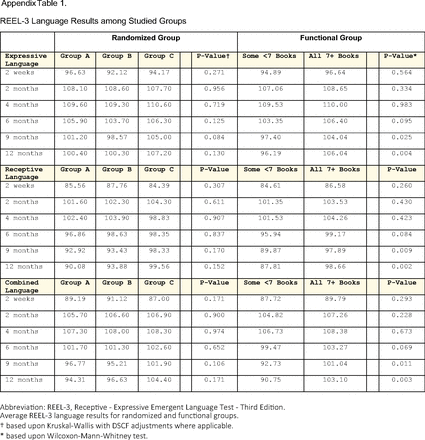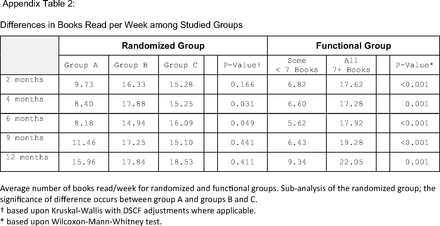Abstract
Introduction: Both expressive and receptive language development begins early in life. While the benefits of reading to toddlers (over 12 months old) is well-established, benefits of reading to infants (birth to 12 months old) is less established. This study’s objective is to determine if consistent reading to infants improves expressive and receptive language development during the first year of life.
Methods: We prospectively randomized infants at a family medicine clinic during their 2-week-old visits and gave them a collection of books. Group A (n = 16) received no instructions, while patients in Group B (n = 18) committed to read 1 book a day. Parents in Group C (n = 18) enrolled after 34 weeks gestation, committed to read 1 book a day, and watch an infant brain development video. We obtained average book counts and both expressive and receptive language testing at standard preventative visits through 12 months.
Results: Language scores did not differ between randomized groups. Always reading 7 books per week led to higher expressive, receptive and combined language scores at 9 months than sometimes reading fewer than 7 books per week (P = .025, 0.009 and 0.011 respectively). These differences increased by 12 months (P = .004, 0.002, and 0.003, respectively). Instructing parents to read daily encouraged parents to read more books per week at 4 months (P = .031) and 6 months (P = .049).
Discussion: Early, consistent reading demonstrates improved language scores as early as 9 months of age. Setting expectations of minimal daily reading impacted daily reading compliance early in life.
- Child Development
- Clinical Medicine
- Communication
- Language Development
- Motivation
- Parents
- Pediatrics
- Primary Health Care
- Reading
Introduction
Reading aloud to children builds language and literacy skills, strengthens parent–child relationships, and establishes a foundation for scholastic and occupational success.1⇓⇓⇓⇓⇓⇓–8 It is one of the most effective ways to improve acquisition of vocabulary and phonological awareness through exposure to enriched language.1⇓–3,9⇓⇓⇓⇓–14 A stimulating home reading environment increases neurological activation in cerebral networks of left temporal and occipital lobes, which are involved in higher order language skills including semantic processing and mental imagery.2,15,16 Furthermore, parent–child bonding from joint focus, unhurried reciprocal interactions, and establishment of routines positively influences parental psychosocial functioning and child behavior.1,2,4,5,9⇓–11,15,17⇓⇓–20 Ultimately, the age at which parents begin reading to their children correlates with language development and academic achievement.1⇓⇓–4,6,9,12,16,17,21,22
Despite basic language development starting from birth, data are limited for reading to infants and the optimal age to initiate shared reading is unknown.1,21,23,24 Childhood interventions, especially by physicians, are effective in guiding and promoting literacy activities.3,7,9⇓–11,18⇓⇓–21 Parents are receptive and highly motivated particularly during the prenatal period.2,8,18,25 Still, late onset and poorly shared reading adherence occur, as reading is often left unaddressed during physician visits from a lack of national guideline consensus.2,3,10,12,13,23,24,25 The objective of this study is to determine the effectiveness of a simple, outpatient intervention to improve expressive and receptive language development of infants through 1 year of age.
Methods
Newborn patients of the institution’s rural family medicine center were sequentially enrolled in the program. Patients were excluded if they had a medical diagnosis that impacted their ability to learn. Guardians consenting at their child’s 2-week visit had their infants prospectively randomized by a predetermined list into 2 groups; group A received a set of twenty books chosen by a speech language pathologist for specific language development rationale (Figure 1). Group A received no instructions, while Group B received the same 20 books along with instructions to read 1+ books per day. No restrictions were made as to order or frequency each book was to be read. A third, nonrandomized group of on-site obstetric patients (Group C), were enrolled in their third trimester. A short video on the importance of brain development in the first year of a child’s life was shown to the mothers of this third group after 34 weeks of their gestation in addition to Group B’s instructions. All groups were given logbooks to record their reading. At standard preventative visits (2 weeks and 2, 4, 6, 9 and 12 months), parents were asked the average number of books per week their child experienced, and their logbook was checked. The infants were also tested with the standardized and maternally rated Receptive–Expressive Emergent Language Test–Third Edition (REEL-3)26 for expressive language (EL), receptive language (RL), and combined language (CL). This test, based on caregiver interview, yields a standard score for children up to 3 years old, displaying results on an IQ-like bell curve. A certified speech language pathologist scored the results. The infants were subclassified into functional groups, those experiencing always at least 7 books (A7+) and sometimes less than 7 books (S < 7) a week, and their EL, RL, and CL development was compared.
Books utilized during the study.
Statistical analyses were performed using SAS 9.427 Due to small sample size and violation of normality assumptions, we implemented nonparametric methods to perform comparisons. The demographic information of gestational age, mother’s education, father’s education, birth order, number of adults and children in the household, and parental ages were compared between different arms using Kruskal–Wallis tests and comparison between functional groups were performed using Wilcoxon–Mann–Whitney tests. For the comparison of categorical variables gender, delivery method, and NICU we implemented chi-square test or Fisher’s exact test. We performed the subgroup analysis by using Wilcoxon–Mann–Whitney tests to compare 2 groups and Kruskal–Wallis tests with Dwass–Steel–Critchlow–Flinger multiple comparisons for more than 2 groups. A P value of < 0.05 was considered statistically significant and a P value between 0.05 and 0.10 was considered marginally significant. The project was approved by the Marshall University Institutional Review Board (Project No.: 749502-7).
Results
Demographics (Table 1) for both the primarily randomized groupings (Groups A through C) were similar for Groups A and B. Group C, the nonrandomized group, only differed by a higher maternal education level (15.2 years) as measured by years of schooling, when compared with both Groups A (13.4 years) and B (13.7 years) together (P = .035). Group A primarily populated the functionally grouped S < 7 and Groups B and C had higher representation in the A7+ groups (P = .007). Maternal differences of 12.6 vs 14.7 years (P = .015) and paternal differences of 12.1 vs 14.1 year (P = .033) existed between the S < 7 and A7+ groups, respectively. A subanalysis infant language scores for low-education mothers (Table 2) were not significant for RL (9 and 12 months: P = .092 and 0.051) and CL (12 months 0.065).
Demographic Characteristics of Groups
Comparison of Language Skills for Infants of Mothers with a Low Education Level
There was a lack of statistical significance through 12 months (Figure 2) for randomized groups in EL (P = .130), RL (P = .152) and CL scores (P = .171). However, statistically significant improvement is seen for functional groups (ie, by number of books read) at 9 and 12 months of age: EL (P = .025 and 0.004), RL (P = .009 and 0.002), and CL (P = .011 and 0.003; see Online Appendix Table 1). Improvement in the number of books read (Figure 3) met statistical significance in the randomized groups at 4 months (P = .031) and 6 months (P = .049), while the A7+ group read two- to threefold more than the S < 7 group at all ages (P ≤ .001; see Online Appendix Table 2).
Longitudinal changes of language scores.
Books each week experienced by infants.
Discussion
Current literature has not evaluated the effect of reading on healthy infants as early as 2-weeks, nor the amount needed for change.25,28,29 This project was designed to analyze these issues and create a practical office-based approach to improve language of infants. By simply obtaining parental commitment of reading 1+ book per day, providing available options for reading materials, and revisiting goals at routine preventative visits, more consistent early reading can be achieved. These principles should be easily applied within a provider’s routine preventative medicine exams of their pediatric patients with little effort or resources.
Parental education level, attitudes regarding reading, and book availability in the home have been shown to be a predictor of reading.30 Educational difference were apparent and expected in the functional groupings (A7+ vs S < 7), as participants self-selected their group by their amount of reading. Some differences in parental education levels in Group C were seen (Table 1). This represents a less than 2-year difference in maternal education that does not cross graduation boundaries. To understand this impact, infant language scores of parents with high school education or less were analyzed against the amount of reading (Table 2). Near significance in RL and CL demonstrate the potential impact of reading in this low-education grouping.
Language Analysis
No statistical differences are seen in the language scores of the randomized groups (Figure 2). Significant increases in EL, RL and CL score for A7+ and S < 7 (Figure 3) occur with separation occurring by 9 months of age. Initial similarities indicate that very young infants are not inherently dissimilar at first and the widening into significance likely displays the cumulative effect of regular reading. As current literature states, starting a consistent reading program with toddlers improves their future language and academic success.1⇓⇓⇓⇓⇓⇓–8 It is clear that these benefits can and should begin earlier in life.
Behavioral Analysis
Determining what impacts parents’ likelihood of completing regular reading was a second study focus. The standard set of children’s books (Figure 1) ensured equal access of all participants and served as the baseline (Group A). Real world application may require other options, like public libraries, or national reading programs. Interventions were setting a goal to read 1+ book per day to their child (Groups B and C) and showing a third trimester a video about child brain development in the first year of life (Group C). Despite a lack of consistent statistical significance among all 3 randomized groups, decreased reading volume was seen in the group not agreeing to read a book each day early in life (4 and 6 months: P = .031 and 0.049) suggesting that instructing parents on daily reading to their infants can be effective. This early consistency is likely essential to achieve the demonstrated language benefits of the functional groups.
Single institution study and size are the primary limitations of the project. Future research should involve confirming these findings on a larger scale and expanding this model to centers with differing governance and patient demographics. Increasing the size of the cohorts may also demonstrate significance when only trends were seen. Parental truthfulness and memory biases in scoring and reading quantification could be minimized by a granular monitoring of reading schedules. In addition, the impact of social determinants, such as parental cultural, psychological, and occupational availability to read, should be explored. Expanding this model to assess genetic, language and even reading media differences could also be considered. We also hope to expand the benefits of this program to infants disadvantaged by neonatal abstinence syndrome.
Conclusion
Regular reading is beneficial to augment language scores for infants as early as 9 months of age and should be encouraged in clinical practice. Parents agreeing to read 1+ books per day trended toward earlier regular reading. Finding ways to impact parents toward reading at least 1 book a day is paramount in the future.
Appendix


Notes
This article was externally peer reviewed.
Funding: This project was funded by an internal $25,000 grant from Marshall University’s Robert C. Byrd Center for Rural Health.
Conflicts of interest: None.
To see this article online, please go to: http://jabfm.org/content/35/6/1156.full.
- Received for publication February 16, 2022.
- Revision received May 15, 2022.
- Accepted for publication July 12, 2022.









